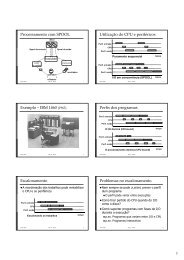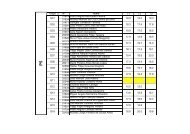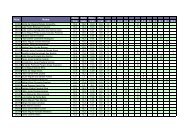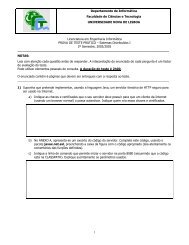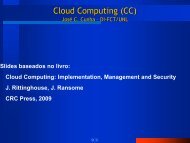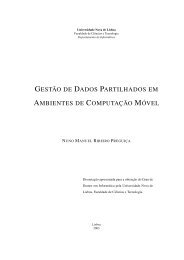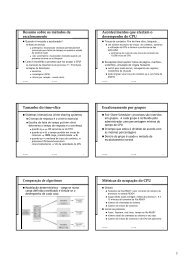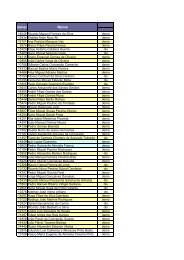Dissertaç ˜ao de Mestrado Mestrado em Engenharia Informática Jo ...
Dissertaç ˜ao de Mestrado Mestrado em Engenharia Informática Jo ...
Dissertaç ˜ao de Mestrado Mestrado em Engenharia Informática Jo ...
You also want an ePaper? Increase the reach of your titles
YUMPU automatically turns print PDFs into web optimized ePapers that Google loves.
3. AN APPLICATION RECONFIGURATION FRAMEWORK 3.2. Automatic Application Configuration<br />
parsers, and continue from the same state later.<br />
10. The user must be able to manually <strong>de</strong>lete parsers from the parser repository.<br />
Description: The user must be able to manually <strong>de</strong>lete parsers from the parser repository<br />
so that the user may intervene if the parser repository becomes to big, or if a certain parser<br />
becomes obsolete.<br />
3.2 Automatic Application Configuration<br />
Having i<strong>de</strong>ntified the requir<strong>em</strong>ents for the tool, it is now possible to tackle a possible solution<br />
for the probl<strong>em</strong>. This section presents a framework which is the solution proposal for the<br />
automatic configuration of applications.<br />
The application configuration files are read by the tool, which parses th<strong>em</strong> in or<strong>de</strong>r to con-<br />
vert their syntax from the original to a generic, application-in<strong>de</strong>pen<strong>de</strong>nt, one. This allows for<br />
the configuration files to be manipulated and altered in the same way, for any application,<br />
through an agent which recognizes the generic syntax.<br />
Being in generic syntax, the file can be efficiently modified by an agent which operates on<br />
that kind of syntax, such as an automated script. Ensuing the file modification, the tool is<br />
responsible to do the inverse conversion, back to the file original form. Once the file has been<br />
converted to the generic syntax, the characteristics of the original syntax have been aprehen<strong>de</strong>d<br />
and can be used to reconvert the file back to its original syntax.<br />
The configuration process (Figure 3.1) can be divi<strong>de</strong>d into three main stages:<br />
1. Configuration file extraction;<br />
2. Original to generic syntax conversion;<br />
3. File modification;<br />
4. Generic to original syntax conversion.<br />
The second stage is accomplished through an Original to Generic syntax Converter (OGC)<br />
and the fourth by a Generic to Original syntax Converter (GOC). This dissertation points ways<br />
in which OGC and GOC might evolve. The first and third stages are not on the original work<br />
scope and therefore are not tackled in <strong>de</strong>tail. Nevertheless, Section 3.5 approaches the file<br />
modification area superficially, hinting at some possible ways of <strong>de</strong>aling with the subject and<br />
i<strong>de</strong>ntifying possible operational constraints.<br />
3.3 Original to Generic syntax Converter<br />
The Original to Generic syntax Converter (OGC) is structured like a three-tier<br />
architecture [Ram00]. The three-tier architecture consists of a software <strong>de</strong>sign pattern which<br />
24



